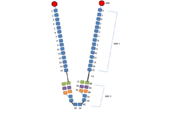Sandbox Reserved 320
From Proteopedia
| |||||||||
| 1faj, resolution 2.15Å () | |||||||||
|---|---|---|---|---|---|---|---|---|---|
| Activity: | Inorganic diphosphatase, with EC number 3.6.1.1 | ||||||||
| |||||||||
| |||||||||
| Resources: | FirstGlance, OCA, PDBsum, RCSB | ||||||||
| Coordinates: | save as pdb, mmCIF, xml | ||||||||
is a ubiquitous enzyme that plays an important role in energy metabolism [1]. Energy metabolism is made possible by soluble inorganic pyrophosphatases (PPases) by their hydrolyzing inorganic phosphates into two molecules of orthophosphate [2]. PPases may have had an important role in evolution by aiding in accurate DNA copying during chromosome duplication [1]. Escherichia coli (E-coli bacteria) and Saccharomyces cerevisiae (S. cerevisiae yeast) PPases, E-PPase and Y-PPase respectively, are the two best studied PPases [1].
Inorganic Pyrophosphatase
Contents |
Structure
E-PPase, a homohexameric protein [3], contains 175 amino-acid residues in each subunit [4]. The protein's topology is described as a five stranded β-barrel that is distorted, highly twisted, and composted of strands β1, β4, β5, β6 and β7, capped on top with α-helix B and the bottom by a loop between strand five and strand six [1]. The active site exists in the bowl formed by the [1].
Function
PPases act to cleave PPi as it is a byproduct in many biosynthetic reactions that include protein, RNA and DNA synthesis[1]. By cleaving the PPi in these synthesis reactions it shifts the equilibrium constants towards biosynthesis [1]. In order to achieve PPi cleavage PPases require a divalent metal ion, usually magnesium [1]. Calcium, alternatively, has been shown to fully suppress PPase activity [2]. PPi hydrolysis is a complicated process that is still not fully understood [2].
References
- ↑ 1.0 1.1 1.2 1.3 1.4 1.5 1.6 1.7 Kankare J, Neal GS, Salminen T, Glumoff T, Glumhoff T [corrected to Glumoff T, Cooperman BS, Lahti R, Goldman A. The structure of E.coli soluble inorganic pyrophosphatase at 2.7 A resolution. Protein Eng. 1994 Jul;7(7):823-30. PMID:7971944
- ↑ 2.0 2.1 2.2 Samygina VR, Popov AN, Rodina EV, Vorobyeva NN, Lamzin VS, Polyakov KM, Kurilova SA, Nazarova TI, Avaeva SM. The structures of Escherichia coli inorganic pyrophosphatase complexed with Ca(2+) or CaPP(i) at atomic resolution and their mechanistic implications. J Mol Biol. 2001 Nov 30;314(3):633-45. PMID:11846572 doi:10.1006/jmbi.2001.5149
- ↑ Wong SC, Burton PM, Josse J. Constitutive inorganic pyrophosphatase of Escherichia coli. V. Reconstitution of native enzyme particles from subunit polypeptide chains. J Biol Chem. 1970 Sep 10;245(17):4353-7. PMID:5498422
- ↑ Lahti R, Pitkaranta T, Valve E, Ilta I, Kukko-Kalske E, Heinonen J. Cloning and characterization of the gene encoding inorganic pyrophosphatase of Escherichia coli K-12. J Bacteriol. 1988 Dec;170(12):5901-7. PMID:2848015


